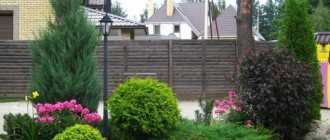What could decorate a garden plot more elegantly than the queen of flowers - the rose. This plant will look great on any site - large and small, flat and rocky. Roses in landscape design are a topic that can be discussed for a very long time, but in this article we will talk about the main features of such garden decoration and give useful recommendations for those who want to grow these beautiful flowers in their garden plot.
Wall with roses in the landscape design of the site
Advantages of decorating the area with roses:
- These flowers occupy a leading position among all other flowers. The rose is used to decorate the garden more often than any other flower.
- The rose fits perfectly into various compositions at the dacha, often plays the main role in them, but at the same time its small inflorescences and miniature varieties can also play secondary roles. A properly organized mono-flower bed with roses can become a real decoration of the garden.
- The variety of varieties of roses makes it possible to choose any of their colors and the size of the bushes in order to decorate your garden in a more harmonious way. At the same time, even in a small area, a bush or miniature rose will look elegant and beautiful.
- Roses in the garden look great in combination with trees, bushes, greenery and other flowers of the summer cottage.
Landing
First of all, you should pay attention to the place where the flowers are planted. A well-lit, wind-protected piece of land is best. Among the characteristics of the plant, one can highlight the fact that they are quite sensitive to sunlight and heat.
The south, southeast side will be an ideal location. You should consider the basic recommendations on how to grow roses.
The most favorable time for planting is spring. After all, roses are heat-loving plants. When the soil warms up at least a little, they begin planting. Roses are rarely planted in the fall. This is a big risk, because not all rose bushes will be able to take root before the cold weather sets in.
Pay attention to the roots of the plant. The roots should not exceed 15-20 cm. If you notice damaged or dried areas, you should cut them off.
The hole for planting the plant should be deep and wide enough. Then it is covered with a layer of earth and watered abundantly. When watering, you must follow the rule: for one bush - one bucket of water. Cover the roses with non-woven material. It will serve as protection from spring sun rays.
Prepare the soil properly. It should be filled with mineral, organic fertilizers. The latter type includes manure, which acts as additional feeding. When fertilizing with mineral fertilizers, take into account the proportion: maximum 15-20 g per rose bush. The fertilizer should be evenly distributed; its excess will negatively affect the further flowering of roses.
Most often, the soil for planting is prepared in the autumn season. The depth of the pit is 1.2 m, its diameter is 0.5 m. It should be filled with branches, expanded clay, crushed stone, then earth with humus and mineral components should be laid. If planting occurs in the fall, prepare the site a month in advance.
Seedlings of the first two years, as you can see in the photo of roses in the garden, are best suited for planting. To stimulate their growth, the tops should be trimmed periodically.
The optimal spacing for planting is 0.5-1 m. Although this recommendation can be neglected, depending on individual preferences and the goal. In particular, large bush roses look beautiful alone. They should be seated keeping a certain distance.
If we are talking about planting small bushes, then the distance is 60-70 cm. Most often, such bushes are planted in order to create borders near paths or flower beds.
Climbing roses are among the single flowers. They grow quickly, so a certain distance should be maintained when planting them. To create a “wall”, this type of roses is used. When transplanting flowers, be as careful as possible so as not to damage the root part or roots.
Adviсe
Keep in mind that you need to arrange flowers next to each other wisely. If you are still a beginner gardener, then it is better to read the relevant websites and literature - not all varieties look equally good side by side in the garden plot. Experienced flower growers advise beginners to plant luxury tea varieties and their hybrids nearby, and to grow ground cover specimens with miniature varieties. These combination options have already been tested and look great. They represent an almost sculptural composition with different drops and steps, making the composition with roses very picturesque. Climbing climbing varieties will look great both solo and in combination with other plants.
Designer alpine slide on the site
When decorating a rose garden or compositions, plant the flowers quite close to each other - this way the planting will look much more impressive. A dense flower bed is also more decorative than sparse plantings.
Beautiful alpine slide on the site
To vertically design a garden plot, it is necessary to use strong supports. Their design can be of any shape. Using supports, you can decorate the area near your dacha with unusual, sometimes even fantastic compositions, which will give it individuality. For example, a spiral support entwined with white and red chic flowers looks great. For vertical landscape design, a climbing rose is usually used. You should know that with the onset of cold weather you cannot remove the lashes from the support, but you need to cover the bushes along with the supports.
Care
In order to observe beautiful roses in the country, you should care for them properly. This includes loosening the soil, proper fertilizing, disease control and other important processes for preserving the flower.
Feeding plays a significant role in the development of roses. The first procedure is carried out in spring, the second - in mid-summer. At the end of this period, you should not fertilize to avoid the appearance of shoots.
You can choose the necessary complex, maintaining balance and moderation. After all, exceeding the norm will entail unpredictable results. At best, you will get improved plant growth, at worst, they will stop growing completely.
Alternate manure and compost for fertilizer every 2-3 years.
Water in the morning or evening once a week. The soil around the bush should be loosened so that the soil is saturated with oxygen.
Pruning occurs in the spring before the buds begin to awaken. Sick, weak stems should be removed. Both weak and strong pruning are used for this process. Use a sharp tool to minimize the risk of damage and wounds to the bark.
At a time when cold weather sets in, it is worth considering shelter. There are certain types of roses that can survive cold, unfavorable conditions without shelter. According to experienced gardeners, it still needs to be used. Begin this process in early November.
Avoid excessively wrapping plants or covering them with spruce branches. Because of this, the roses will die. For shelter, use peat, or just loose soil. The layer should not exceed 10-15 cm.
In one season, it is necessary to spray roses with special means about three times. This will protect the plant from fungal diseases, pests, or rust.
Why a rosary
Traditionally, roses were planted in rose gardens. In relatively recent times, there was an opinion that they should be grown exclusively in monoculture, and this practice did not develop by chance. In a rose garden it is much easier to provide all the necessary conditions: the quality of the soil substrate, fertilizing and watering, treatment against diseases and pests, mulching. But the most important thing is winter shelter. Experience has shown that solitary roses winter worse than those growing in masses. A single “roof over their heads” allows them to be in more comfortable temperature conditions. By covering a sufficiently large area of land (and it is the earth that warms!), we provide our pets with a reliable wintering.
Roses as a monoculture. Photo by the author
When choosing suitable plants to accompany solo roses, we should give preference to those types of plants that, firstly, will not compete with them for light, water and nutrition. And secondly, they will not overshadow the delicate beauty of beauties.
But we must remember that, on the other hand, not all plants will tolerate the requirements of agricultural technology that is used in growing roses. Therefore, you need to select companions for a rose carefully and with caution - both in the rose garden and for separately growing specimens.
Varieties
There are many varieties of roses, and their list is constantly growing. According to statistical studies, every year the number of varieties increases by 200. Park and garden roses are used for landscaping for decorative purposes.
They do not require shelter and can withstand the winter season with minimal protection. For example, spiny or bluish varieties. Frost-resistant roses include Damask, white, and French varieties.
Garden roses are bred through selective breeding. In order to grow such flowers, agricultural technology is used. These are delicate flowers that require protection in the cold season. Their number at this time is about 20,000. Moss, Cordes, miniature, semi-climbing varieties are among the most popular types.
Design style
First of all, you need to decide how to design the flower garden. It will be strictly rectangular, oval, or this shape will be free, not necessarily correct.
It's worth thinking about edging. One way to decorate it is with brick and marble chips, crushed stone and pebbles, or simply a low fence.
Even if you don’t adhere to geometric shapes, there should be order in the flowerbed, even if it’s creative.
conclusions
Roses are considered one of the most beautiful and fragrant flowers. In order to grow such flower waterfalls, you need to follow certain recommendations and properly care for the plants. This concerns the choice of location, feeding, and other important processes.
If grown correctly, your flowerbed will be rich in these noble bushes.
Delphinium
Delphinium inflorescences pointing upward are an excellent backdrop for a rose garden. The flowerbed can be made multi-colored or monochrome, consisting of two types or including dozens more plants.
It is not recommended to plant a rose close to a delphinium. The latter is distinguished by a well-branched rhizome that can inhibit surrounding plants.
Photo of roses in the garden
Fennel
Fragrant fennel attracts pollinating insects to rose bushes, causing flower beds to bloom throughout the summer. Many gardeners choose to combine these two plants in the same bed because of their medicinal properties.
Rose petals are valued for their high vitamin C content, and fennel is considered almost the main garden “healer”. It is used for colds, intestinal problems, and for cosmetic procedures.
Khosta
During flowering, all the splendor of the rose bush is concentrated at the top. The lower part remains uncovered and, in most cases, looks inconspicuous. The host helps fill the space and add volume. A perennial ornamental grass with lush, often two-colored leaves, it grows in neat bushes on the lower tier.
Unlike roses, hosta prefers moist soil and light shade. To prevent such a flower bed from withering away after the first year of planting, you must try to please both crops at once. Suitable humidity is provided by a drip irrigation system.
Parsley
In addition to ornamental crops, rose bushes get along well in the same bed with fragrant parsley, oregano and thyme. The latter, with their aroma, repel pests from flower beds, ensuring calm flowering throughout the summer. A lush carpet of small-leafed greenery prevents weeds from settling in the flowerbed, and a plain background favorably emphasizes the beauty of the inflorescences.
When selecting neighbors, it is important to pay attention not only to the visual compatibility of colors, but also to their requirements for soil quality. There should be enough nutrition, light and moisture for both crops.











